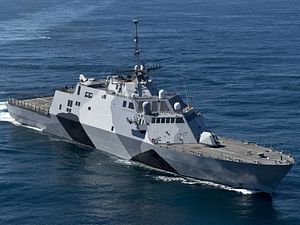One theme of modern defense acquisition – explored previously in this column, among many other places – is that modern high-end military systems are increasingly expensive and difficult to procure in large numbers.
This is true in the West, where cost overruns and expensive, cancelled projects are big news. But it is likely just as true in less open societies – the new Chinese supercarrier, built to nearly the same scale as a U.S. Nimitz- or Ford-class ship, doubtless has a high price tag, even if it has not been disclosed publicly.
In an era that has until now mostly been defined by irregular and asymmetric wars, it has become common practice to point out the disparity between the expensive, technologically sophisticated weapons employed by the world’s most powerful militaries and the collection of improvised, dated, and captured arms used by their non-state adversaries.
I was reminded of this dynamic by the death last week of twice-serving former U.S. Secretary of Defense Donald Rumsfeld. Rumsfeld’s more recent tenure as secretary of defense saw him on both sides of this dynamic: he pushed to cancel a number of over-budget, over-complicated weapons systems, which did not fit into his vision of a streamlined, fast-moving fighting force; but he also downplayed the effectiveness of informal, lightly-equipped irregulars, at enormous strategic, financial, and human cost.
Of course, the world has moved on in many ways since Rumsfeld found himself cast aside in the wake of his party’s repudiation in the 2006 midterm elections. With “great power competition” back to dominating strategic conversations, more sophisticated and expensive weapons systems are demanding more and more attention from decision-makers in the United States, as well as in U.S. allies and U.S. competitors alike. That has contributed to a growth in global military expenditure that persisted regardless of the social and budgetary pressures imposed by the pandemic.
But the basic principle has not changed. A more expensive weapon is not necessarily a more useful weapon; and a more useful weapon is not necessarily the decisive factor in a conflict. This was true when Chadian forces in Toyota pickup trucks overran and routed Libyan troops with main battle tanks and ground attack aircraft in 1987; it was true when the Islamic State pushed massively more numerous and well-armed Iraqi forces out of northern Iraq in 2014; and it remains true today, as the Taliban rapidly push the Afghan army back in the wake of the withdrawal of U.S. and European forces.
To be clear, that is not to suggest that major military forces should trade their frontline systems for pickup trucks and recoilless rifles. More expensive systems do genuinely have capabilities that, when used correctly, far outstrip those of cheaper systems. Irregular forces are generally capable of defeating better-equipped adversaries because of advantages such as willingness to accept greater casualties, familiarity with local terrain, the complacency or incompetence of their adversaries, and the acquiescence of the local population, rather than the inherent superiority of cheap and common equipment.
Rather, the question is one of adaptation. This, unfortunately, has not proven to be particularly easy. Where industrialized militaries try to develop new weapons and tactics using the same flexible methods as irregular forces, the results have been at best mixed. Take, for example, the U.S. Navy’s Littoral Combat Ship program, designed to produce a cheap, fast, and flexible light warship, which could be rapidly reconfigured to carry out mine warfare, surface warfare, or expeditionary operations. As a result of both immature technology and political compromises, the result was an extraordinarily expensive ship with limited flexibility and firepower. The Navy’s response was to curtail its order and re-bid for a more traditional multi-mission frigate. The Air Force’s efforts to buy a cheap, lightweight attack aircraft for counterinsurgency and foreign partnership missions has similarly run through a protracted evaluation process without producing much in the way of operational aircraft. The problem is that, given enormous financial resources, failures such as these simply don’t seem to register enough to prompt a wholesale re-think of acquisition and developmental practices.
Improvisation with systems and tactics involves risk, of course, and industrialized militaries – particularly those of democratic states – tend to be risk-averse except in unusually dire circumstances. That said, the increasing proliferation of remotely-operated systems, which can be made cheaply and quickly and used experimentally with limited risks, might well provide a mechanism through which established militaries could experiment with new operational concepts, a type of experimentation already pioneered by irregular groups, (and now to some extent by militaries).
Donald Rumsfeld was wrong about many things, but high on the list was his famous answer to a soldier who wanted to know why the U.S. military’s vehicles weren’t armored against roadside bombs: “You go to war with the army you have.” In fact, an army is an entity that is constantly in flux, balancing inertia, tradition, and institutional knowledge against technological and tactical innovations. It would be a mistake to entirely disregard the former, but to ignore the ways in which scarcity and forced improvisation produce genuine innovation is to leave that army blinded to its own weaknesses in the next conflict.

































